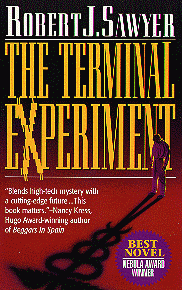Fact catching up with Fiction: The Terminal Experiment
by Rob - June 27th, 2008.Filed under: Uncategorized.

This has been a good month for fact catching up with fiction in the novels of Robert J. Sawyer …
Not only is CERN’s Large Hadron Collider, which I wrote abut in 1999’s Flashforward, finally about to come on line, but now the Parliament of Spain has approved a resolution to grant some human rights to apes, under the terms of the Declaration on Great Apes, which I wrote about in my 1995 Nebula Award-winning novel The Terminal Experiment:
When Peter Hobson had taken a university elective in taxonomy, the two species of chimpanzees had been Pan troglodytes (common chimps) and Pan paniscus (pygmy chimps).
But the split between chimps and humans had occurred just 500,000 generations ago, and they still have 98.4% of their DNA in common. In 1993, a group including evolutionist Richard Dawkins and bestselling science-fiction writer Douglas Adams published the Declaration on Great Apes, which urged the adoption of a bill of rights for our simian cousins.
In took thirteen years, but eventually their declaration came to be argued at the UN. An unprecedented resolution was adopted formally reclassifying chimpanzees as members of genus Homo, meaning there were now three extant species of humanity: Homo sapiens, Homo troglodytes, and Homo paniscus. Human rights were divided into two broad categories: those, such as the entitlement to life, liberty, and freedom from torture, that applied to all members of genus Homo, and other rights, such as pursuit of happiness, religious freedom, and ownership of land, that were reserved exclusively to H. sapiens.
Of course, under Homo rights, no one could ever kill a chimp again for experimental purposes — indeed, no one could imprison a chimp in a lab. And many nations had modified their legal definitions of homicide to include the killing of chimps.
Adriaan Kortlandt, the first animal behaviorist to observe wild chimpanzees, once referred to them as “eerie souls in animals’ furs.” But now Peter Hobson was in a position to see how literally Kortlandt’s observation should be taken. The soulwave existed in Homo sapiens. It did not exist in Bos taurus, the common cow. Peter supported the simian-rights movement, but all the good that had been done in the last few years might be undone if it were shown that humans had souls but chimps did not. Still, Peter knew that if he himself did not do the test, someone else eventually would …
(Excerpt from Chapter 12 of The Terminal Experiment by Robert J. Sawyer; scene written Thursday, July 29, 1993.)
The Robert J. Sawyer Web Site

